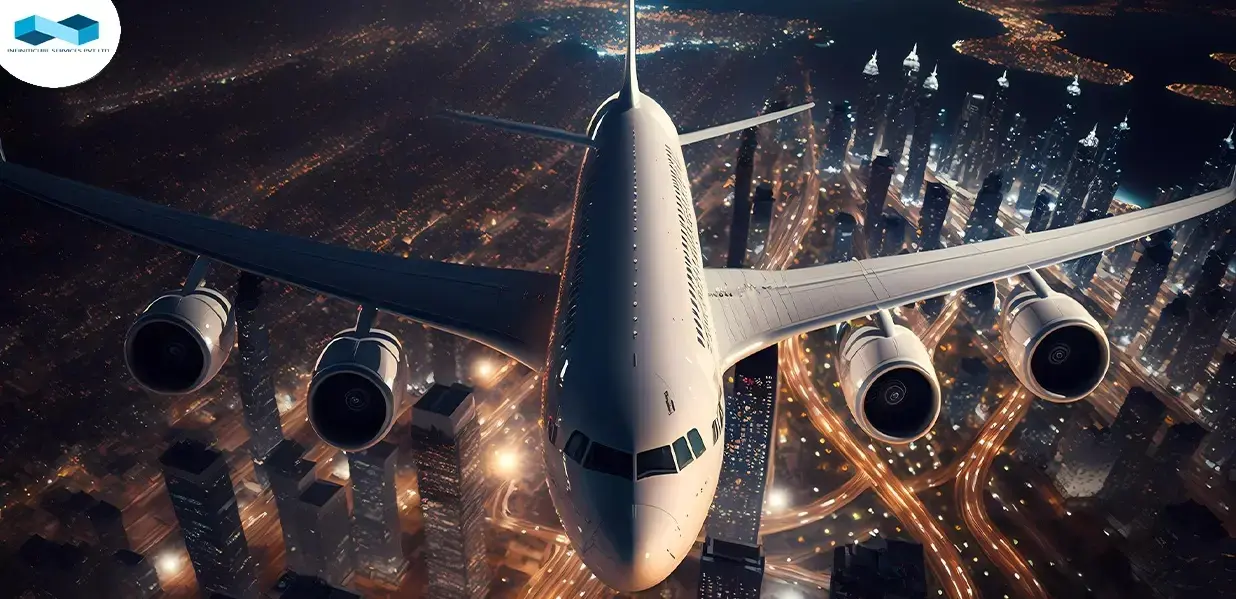How Smart Sensors Driving Aerospace Industry Towards Growth
The aerospace industry has come a long way since the Wright brothers' powered flight in 1903. This sector has evolved from simple gliders to sophisticated aircraft, satellites, and even space exploration vehicles. Innovations have propelled advancements in materials, design, propulsion systems, and avionics, transforming how we travel and explore space.
The journey from propeller-driven aircraft to jet engines and now to the possibilities of electric and hybrid propulsion showcases the industry's commitment to innovation and efficiency.
Exploring how smart sensors are pivotal in driving growth in the aerospace industry unveils a fascinating intersection of technology and aviation. These sophisticated devices enhance the functionality, safety, and efficiency of aerospace vehicles and systems.
By integrating smart sensors, the industry is not only meeting the current demands for safer and more efficient travel but also paving the way for future innovations. This exploration will delve into the various dimensions of smart sensors' impact on the aerospace industry, underscoring their significance in driving the sector's growth.
The Role of Smart Sensors in Aerospace
Smart sensors in aerospace industry offer sophisticated solutions for monitoring, control, and safety. Below, we explore their various applications in detail:
Aircraft Health Monitoring
- Vital Sign Tracking: Just like a doctor checks a patient, smart sensors assess an aircraft's health by monitoring engine performance, structural integrity, and system efficiencies.
- Predictive Maintenance: By predicting potential failures before they happen, smart sensors can save time and money, ensuring that maintenance is only performed when necessary.
- Real-Time Data Analysis: Flight data is continuously analyzed, allowing for immediate adjustments to enhance performance and safety.
Environmental Control Systems
- Cabin Comfort: Sensors monitor and adjust temperature, humidity, and air quality to ensure passenger comfort throughout the flight.
- Energy Efficiency: Smart sensors optimize the use of energy within the aircraft, reducing fuel consumption and environmental impact.
- System Integrity: By constantly monitoring the environmental control systems, sensors can quickly identify and address any discrepancies, ensuring optimal operation.
Navigation and Control
- Precise Positioning: Advanced sensors provide accurate location data, improving navigation and flight path optimization.
- Autopilot Enhancements: With the help of smart sensors, autopilot systems can make more informed decisions, enhancing safety and reliability.
- Weather Adaptation: Sensors detect changes in weather conditions, allowing pilots to adjust course or altitude for safer travel.
Case Studies or Examples of Smart Sensor Implementation in Modern Aircraft
- Boeing 787 Dreamliner: Utilizes advanced health monitoring systems with smart sensors to track and predict maintenance needs, significantly reducing downtime.
- Airbus A350 XWB: Features sophisticated environmental control sensors that adjust cabin conditions to maximize passenger comfort and reduce energy consumption.
The Impact of Smart Sensors on Safety and Maintenance
- Enhanced Safety Measures: Smart sensors provide critical data that can prevent accidents by detecting issues before they become serious problems.
- Maintenance Efficiency: The ability to predict maintenance needs reduces unnecessary inspections, saving time and resources.
- Cost Reduction: By improving maintenance scheduling and reducing emergency repairs, smart sensors significantly cut operational costs.
Also Read: How Smart Sensors Are Driving Smart Cities Towards Growth
Driving Forces Behind the Adoption of Smart Sensors
Smart sensors are increasingly becoming integral components of the aerospace industry. Their adoption is being driven by several critical factors, each contributing to the industry’s evolution towards more efficient, safe, and sustainable operations. Here’s a breakdown of these driving forces:
Increasing Demand for Fuel Efficiency and Sustainability
- Fuel Cost Savings: Smart sensors monitor engine performance and aircraft conditions in real-time, allowing for adjustments that maximize fuel efficiency.
- Environmental Impact: With global emphasis on reducing carbon footprints, smart sensors help in monitoring and managing emissions, contributing to more eco-friendly flights.
- Operational Efficiency: They optimize flight paths and reduce unnecessary fuel burn by providing accurate data for better decision-making.
Regulatory Requirements and Safety Standards
- Compliance: International aviation authorities mandate strict compliance with safety and operational standards. Smart sensors ensure that aircraft meet these requirements through continuous monitoring and diagnostics.
- Enhanced Safety Measures: By detecting potential issues before they escalate, smart sensors significantly improve aircraft safety, reducing the risk of accidents and malfunctions.
- Maintenance and Inspection: Regulatory bodies require regular maintenance and inspection of aircraft. Smart sensors facilitate predictive maintenance, alerting before parts wear out or fail.
The Role of Data Analytics and AI in Enhancing the Capabilities of Smart Sensors
- Predictive Analytics: Data collected by smart sensors is analyzed using AI to predict potential system failures, significantly reducing downtime and maintenance costs.
- Personalized Aircraft Operations: AI algorithms process data from smart sensors to tailor operations to specific aircraft conditions, improving efficiency and performance.
- Enhanced Decision-Making: By providing a comprehensive view of aircraft health and environmental conditions, data analytics and AI enable better decision-making, enhancing overall safety and operational efficiency.
Also Read: How Smart Sensors Driving Automotive Industry Towards Growth
Challenges and Solutions For Smart Sensors in Aerospace Industry
The integration of smart sensors into aerospace systems marks a significant leap towards modernizing and enhancing the efficiency and safety of aerospace vehicles. However, this integration is not without its challenges. Understanding these challenges and the solutions being developed to overcome them is crucial for the continued growth and innovation within the aerospace industry.
Technical Challenges in Integrating Smart Sensors into Aerospace Systems
- Complex Integration: Smart sensors must work seamlessly with existing aerospace systems, which often involves complex integration processes due to the varied nature of legacy systems.
- Solution: Development of universal standards and protocols for smart sensors, facilitating easier integration.
- Harsh Environmental Conditions: Aerospace vehicles operate under extreme conditions, posing a challenge for the durability of smart sensors.
- Solution: Advancements in materials science to develop more robust sensors that can withstand high pressures, temperatures, and radiation.
- Power Consumption: Smart sensors require power, yet aerospace systems often have strict energy budgets.
- Solution: Research into low-power electronics and energy-harvesting technologies to make sensors more energy-efficient.
Addressing Cybersecurity Risks Associated with Smart Sensors
- Vulnerability to Attacks: The interconnected nature of smart sensors increases the potential for cybersecurity threats.
- Solution: Implementation of robust encryption and cybersecurity measures tailored to the unique requirements of aerospace systems.
- Data Integrity: Ensuring the accuracy and integrity of the data collected by smart sensors is paramount for safety.
- Solution: Use of advanced data verification techniques and redundant sensor systems to validate data accuracy.
- Regular Updates and Maintenance: Keeping smart sensor systems secure requires continuous monitoring and updates.
- Solution: Development of secure, automated update processes to ensure systems remain protected against new threats.
Future Trends in Material Science and Electronics that Could Overcome Existing Limitations
- Nanotechnology: The use of nanomaterials in sensor construction could significantly enhance their sensitivity, durability, and energy efficiency.
- Future Implication: Nanotechnology could enable the development of sensors that are not only more reliable in extreme conditions but also self-repairing.
- Internet of Things (IoT) Integration: Further integration of smart sensors with IoT technology can enhance data collection and analysis capabilities.
- Future Implication: This could lead to more autonomous aerospace systems capable of predictive maintenance and real-time decision-making.
- Quantum Computing and Sensing: The potential application of quantum technologies in sensors promises unprecedented levels of precision and sensitivity.
- Future Implication: Quantum sensors could revolutionize navigation systems, significantly improving the accuracy and safety of aerospace vehicles.
Also Read: How Smart Sensors Driving Industry 4.0 Towards Growth
Future Trends and Innovations
Emerging Technologies in the Field of Smart Sensors
Nanotechnology
- Miniaturization of sensors allows for integration into nearly any part of an aircraft, enhancing precision and efficiency.
- The development of nanosensors can lead to improvements in the detection of environmental changes and structural health monitoring.
- Nanotechnology enables the creation of more durable sensors that can withstand extreme conditions, crucial for aerospace applications.
IoT Integration
- Connectivity among sensors through the Internet of Things (IoT) allows for real-time data collection and analysis, improving decision-making processes.
- IoT-enabled sensors facilitate predictive maintenance, reducing downtime and extending the lifespan of aerospace equipment.
- Integration with cloud computing provides a platform for advanced analytics, enhancing safety and operational efficiency.
- Potential Future Applications of Smart Sensors in Aerospace
Unmanned Aerial Vehicles (UAVs)
- Enhanced navigation and control through precise environmental sensing, improving UAVs' adaptability to diverse conditions.
- Real-time health monitoring of UAVs, enabling autonomous decision-making for maintenance and route adjustments.
- Increased use in remote sensing and surveillance, benefiting from the advanced capabilities of smart sensors.
Space Exploration
- Smart sensors can significantly contribute to the safety and success of missions by providing accurate measurements of cosmic conditions.
- In space habitats, sensors monitor life support systems, ensuring the well-being of astronauts.
- Exploration rovers equipped with advanced sensors can autonomously navigate and conduct scientific research on planetary surfaces.
- How Ongoing Research and Development in Smart Sensors Could Shape the Future of the Aerospace Industry
Enhanced Safety and Reliability
- Continuous improvement in sensor technology will lead to even more reliable and accurate monitoring systems, crucial for the safety of air and space travel.
- Advanced diagnostics capabilities will allow for the early detection of potential issues, preventing accidents.
Increased Efficiency and Cost-Effectiveness
- With the advancement of smart sensors, aerospace operations will become more efficient, reducing fuel consumption and emissions.
- The ability to predict and prevent failures through smart sensors reduces maintenance costs and extends the lifespan of aerospace equipment.
Innovation and Exploration:
- The integration of cutting-edge sensor technology will open new frontiers in aerospace, including more ambitious space missions and innovative aircraft designs.
- Smart sensors will play a key role in the development of autonomous flying vehicles and commercial space travel, transforming how we explore and utilize airspace and outer space.
Conclusion
This exploration has revealed the significant role of smart sensors in the aerospace sector, transforming aviation through enhanced monitoring and navigation. Smart sensors, essential for fuel efficiency, safety, and data analytics integration, are driving aerospace innovation toward more sustainable and efficient practices.
Their use in predictive maintenance reduces costs and improves aircraft reliability, supporting the growing demand for air travel while maintaining environmental and safety standards. Looking forward, the blend of smart sensors with emerging technologies like nanotechnology and IoT promises to further advance aerospace, making it safer and broadening horizons for UAVs and space exploration. The future of aerospace lies in the continued integration of smart sensors, a key to unlocking new possibilities in aviation.
Don't let critical insights slip through the cracks. With Infiniticube Services, you're equipped to make informed decisions that enhance safety, efficiency, and innovation. Elevate your aerospace operations with the power of advanced data analytics. Let us be your co-pilot in this journey of innovation and efficiency. Dive into the data wave with us and emerge as a leader in the aerospace frontier. Contact Us for hiring our services!
You can also schedule a call with our expert to discuss your requirements.
 June 27, 2025
June 27, 2025
 Balbir Kumar Singh
Balbir Kumar Singh
 0
0
 June 13, 2025
June 13, 2025
 Balbir Kumar Singh
Balbir Kumar Singh
 0
0









Leave a Reply